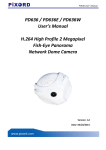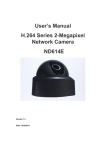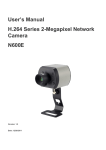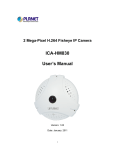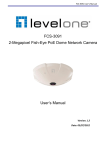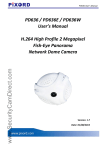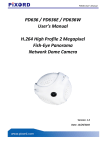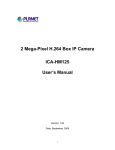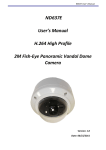Download ND636E User's Manual H.264 High Profile 2 Megapixel Fish
Transcript
ND636 User’s Manual ND636E User’s Manual H.264 High Profile 2 Megapixel Fish-Eye Panorama Network Dome Camera Version: 1.5 Date: 26/12/2011 ND636 User’s Manual Contents Notices ...........................................................................................................................................................2 Introduction....................................................................................................................................................3 Installation .....................................................................................................................................................4 Using the Web UI ........................................................................................................................................15 1. Live View ..........................................................................................................................................16 2. Video ................................................................................................................................................19 General .........................................................................................................................................19 3. Camera .............................................................................................................................................26 General.........................................................................................................................................26 Advanced .....................................................................................................................................28 4. Event ................................................................................................................................................34 Event Server.................................................................................................................................35 Motion Detection .........................................................................................................................37 I/O Ports .......................................................................................................................................40 Event Configuration.....................................................................................................................41 5. Schedule ...........................................................................................................................................43 General .........................................................................................................................................43 Storage ..................................................................................................... 6. Network ...........................................................................................................................................44 General .........................................................................................................................................46 Advanced .....................................................................................................................................47 SMTP (E-Mail) ............................................................................................................................48 DDNS ..........................................................................................................................................49 7. System ..............................................................................................................................................50 Information ..................................................................................................................................50 User ..............................................................................................................................................51 Date & Time ................................................................................................................................52 Server Maintenance .....................................................................................................................53 Log Service ..................................................................................................................................54 8. Customize.........................................................................................................................................55 FAQ ...............................................................................................................................................................57 Restore Factory Default .......................................................................................................................57 I/O Terminal Connector - Pin Assignment ...................................................................................58 1 1 ND636 User’s Manual Notices This user manual is intended for administrators and users of the ND636 Network Camera, including instructions for using and managing the camera on your network. The use of surveillance devices may be prohibited by law in your country. It is the user’s responsibility to ensure that the operation of such devices is legal before installing this unit for its intended use. Before the Network Camera is installed, all the safety and operating instructions should be carefully read and followed to avoid damage due to faulty assembly and installation. This also ensures the product is used properly as intended. Heed all warnings Do not drop or strike this equipment Sensitive electronics inside the camera are vulnerable to excessive strike. Do not install the equipment near any flames or heat sources Excessive heat could damage this equipment. Do not cover cloth or to install this equipment in poorly ventilated places. Overheating could damage this equipment. Do not expose this equipment to rain or moisture. Do not touch the power connection with wet 2 hands Risk of short circuit, electric shock or fire Do not damage the power cord or leave it under pressure Risk of fire or shock circuit To reduce the risk of electric shock, do not remove the Cover (or Back). No user-serviceable parts inside. Misusage, improper, and negligence could damage this equipment. Need to refer servicing to qualified service personnel. Do not continue to operate if there appears to be fault. If the unit ceases to function, contact qualified service personnel for help. All work related to the installation of this product should be made by qualified service personnel or system installers. 2 ND636 User’s Manual Introduction ND636 is a Fish-Eye Panorama Network Dome Camera featured with 2Mega Pixel resolution and superior H.264-AVC performance and rich functions. ND636 includes a fish-eye lens for 360° panoramic wide angle view without blind spot. It is very suitable to view a wide area with single camera such as hallway, store, and office without the need to install multiple cameras. The hardware base panorama video processing ability provides user flexible video layout including broad view, double broad view, 3 PTZ view, QUAD view, and table view. The e-PTZ function, pan, tilt and Zoom In/Out without moving parts, can replace traditional PTZ camera and thus save lost of traditional mechanical Pan/Tilt maintain cost. The PoE function (ND636E) is designed for flexible installation. Further functions include two-way audio, DI/DO alarm application and micro SD card support for local storage application. 3 3 ND636 User’s Manual Installation ND636(E) – Physical Overview 4 Interface Description Light Sensor The Light sensor is for detecting IP Camera environmental illumination, and if IP Camera was in the dark/night environment, IR Cut Filter is switched off to let infrared light pass through for clear night view. MIC The IP Camera has built-in an internal microphone, which is hidden in the pinhole located on the front panel. Lens Focus Adjustment Rotate the lens to adjust the focal length to the best image. If necessary, clean the lens with a soft cotton cloth. Speaker The IP Camera has built-in an internal speaker, which is hidden in the pinhole located on the front panel. Reset Button This button is hidden in the pinhole. For more information, please refer to page 53 FAQ for Restore Factory Default instruction. 4 ND636 User’s Manual Interface Contents Power Jack The input power is DC 12V, 2A. Note: ONLY use package power adapter supplied with the internet. Otherwise, the product may be damaged. RJ-45 LAN Socket Connect to PC or Hub / Switch. For connect to 10Base-T Ethernet or 100Base-TX Fast Ethernet Cabling. This Ethernet port built audio-negotiation protocol which can detect or negotiate the transmission speed of the network automatically. Please use CAT-5 cable to connect the Network Camera to a 100Mbps Fast Ethernet network switch or hub. Note: ONLY use one power source, either from DC or from 802.3af Power over Ethernet. Micro SD Card slot The IP Camera has built-in a Micro SD card slot which can accepts Micro SD memory card for image / video event recording. Audio In Connect a microphone to the IP Camera, be noted to use actively microphone (normally with power supplier on microphone) for this application. Audio Out Connect a loud speaker to the IP Camera. This is for voice alerting and two-way audio. Be noted to use actively speaker (normally with power supplier on speaker) for this application. GPIO The 7 pin terminal block includes 4 input ports and 1 output ports. 5 5 ND636 User’s Manual 1. Hardware Connection 1. Prepare a PC with Ethernet link to the network 2. Connect LAN port (RJ45) of the camera to a network switch/hub 6 3. Connect power jack 4. Ensure the power adaptor specification matches the power system (110V or 220V) and connect the adaptor to the outlet 5. Check LED status (Power/Network) 6 ND636 User’s Manual 2. Mounting Bracket Installation Carefully follow the steps to ensure correct installation. 7 7 ND636 User’s Manual 3. Software Installation The following software is necessary for the proper display and use of the ND636 from the Web site. The software will be taken from the Software Package CD. IP Installer The IP Installer is used to locate and configure network cameras and video servers on the LAN. This utility is useful for conveniently configuring the network settings of the device, or for finding a device once the network settings have been modified. To install the IP Installer, from the Software Package CD, select IP installer, then follow the on instructions to complete the installation. XVID Codec An H.264 codec is applied for displaying the video stream and playing the recoded AVI files. If the video stream can’t be displayed or the recorded AVI files can’t be play on PC, install this software from the Software Package CD. VLC Though not necessary, this can be used for viewing the streaming without a Web browser. 8 8 ND636 User’s Manual 4. Network Configuration IP Installer is a utility that provides an easier, more efficient way to configure the IP address and network settings of the devices. It even provides a convenient way to set the network settings for multiple devices simultaneously using the batch setting function. NOTE: Default mode is DHCP. Preparation before IP Assignment 1. Always consult your network administrator before assigning an IP address to your server in order to avoid using a previously assigned IP address. 2. Ensure the ND636 is powered on and correctly connected to the network. 3. MAC Address: Each device has a unique Ethernet address (MAC address) shown on the label of the device as the serial number (S/N) with 12 digits (e.g. 000429-XXXXXX). *0004290000 B1 4. Although the IP Installer is able to find and configure any ND636 on the LAN except those that are behind a router, it is a good idea to set the host PC to the same subnet. In order to connect to the Web-based user interface of the camera, the host PC must be in the same subnet. For more information about subnets, please consult your network administrator. Using IP Installer to Assign an IP Address to ND636 1. Once IP Installer has been successfully installed on the PC, double click to run the software. 9 9 ND636 User’s Manual 2. Click the [Device Search] to search the device in the LAN. 3. From the list, select the device with the MAC Address that corresponds to the ND636 that is to be configured. The MAC Address is identical to the unit’s S/N (Serial Number). 4. Double click the select item to open the Property Page or right click the item to select the [Single Device Setting] 10 5. Modify the network settings of the camera. 10 ND636 User’s Manual 6. After filling in the properties, click [Set] button to complete the configuration settings. 11 11 ND636 User’s Manual 7. Click the [Batch Device Setting] to set several devices. 12 8. Language support for Chinese, English and Spanish. 12 ND636 User’s Manual Open the Web-based UI of the selected camera 1. To access the Web-based UI of the selected unit, run the View > Open Web on the menu bar. 13 2. For first time user, there will be a prompt to install the ActiveX control. Confirm the installation as it is required to view the video stream and some operations. 13 ND636 User’s Manual 3. If the device has been configured correctly, the default Web browser will open to the home page of the selected device. Verify and Complete the Installation from Your Browser When browsing the Home Page at the first time with the Microsoft Internet Explorer TM , you must temporarily lower your security settings to perform a one-time-only installation of the ActiveX component onto your workstation, as described below: 1. From the Tools menu, select [Internet Options] 2. Click the [Security] tab and then click [Custom Level] button to see your current security settings. 3. Set the security level to Low and click [OK]. 4. Type the URL or IP address of your camera into the Address field. 5. A dialog box will pop up asking if the ActiveX control should be installed. Click [Yes] to start the installation. 14 Once the ActiveX installation is complete, return the security settings to their original value, as noted above. 14 ND636 User’s Manual Using the Web UI Start your Web browser and enter the URL or IP address in the Address field. The Home page of the camera is now displayed. 1. Launch a web browser, 2. Enter the IP address of the camera in the address field of the browser, 3. The login process will require username and password for a new session connection. The default username/password is admin/admin. 15 4. After authorized, the web will be directed to the main page of the camera with the live video 15 ND636 User’s Manual 1. Live View IP address of the camera Button Video format Resolution Frame Rate Bit rate Description Click for more general/advance camera settings 16 Select languages among English, traditional Chinese and simplify Chinese Select display mode to view the different type of the video layout. Check actual size to view the actual size (resolution) of the image Applied as one of the trigger conditions Choose among the 2 streams for viewing 16 ND636 User’s Manual Button Description Full screen 17 Listen the audio input from local end Talking function Record instant live video Snapshot the image 17 ND636 User’s Manual Configuration Pages List Video General Advanced Camera General Advanced Event Event Server Motion Detection I/O ports Event Configuration Schedule General Storage Network General Advanced SMTP (E-mail) DDNS 18 System Information User Date & Time Server Maintenance Log Service Customize Style Layout 18 ND636 User’s Manual 2. Video This section describes how to configure the video streaming from the device, and the related camera image configurations. Users with Administrator or Operator authority are intended for these configurations. Click on SETUP button to enter in the configuration pages. General 19 OSD Setting: Enable OSD to display camera name and date/time on the image. The PTZ function will display in Broad view, Quad view, Quad with source view, Double view and Triple view of Ceiling Mount. Click on the PTZ icon, the web will popup the control panel to control e-PTZ function of ND636. 19 ND636 User’s Manual Broad view PTZ control panel: (Mount=Ceiling) 1 2 3 4 1. Step: Setting the speed of Pan function. (1~10) 2. Move the control panel. 3. Close the control panel. 4. Pan Arrow: Click to control Pan function. Double view PTZ control panel: 20 (Ceiling mount) 1 2 4 1. Step: Setting the speed of Pan function. (1~10) 2. Move the control panel 3. Close the control panel. 4. Pan Tilt Arrow: Click to control Pan/Tilt function. 20 3 ND636 User’s Manual Double with source view PTZ control panel: (Mount=Wall 720P) 1 2 3 4 5 6 21 1.Step:Sets the speed of Pan/Tilt function. (1~10) 2. Move the control panel. 3. Close the control panel.. 4. Pan Tilt Arrow:Click to control the Pan/Tilt function. 5. Zoom:Digital zoom in/out. (1~10) 6. List of preset points. (1~16) 21 ND636 User’s Manual Triple view PTZ control panel: (Mount=Ceiling) 1 2 3 4 5 6 22 1. Ch:Select the channel. (1~3) 2. Step:Sets the speed of Pan/Tilt function. (1~10) 3. Move the control panel. 4 .Close the control panel.. 5. Pan Tilt Arrow:Click to control the Pan/Tilt function. 6. List of preset points. (1~16) 22 ND636 User’s Manual Quad view & Quad with source view & Triple view & Double view PTZ control panel: (Mount = Wall、Ceiling、Wall720P) 1 2 5 6 3 4 7 23 1. Ch:Select the channel. (1~4) & (2~4) & (1~2) 2. Step:Setting the speed of Pan/Tilt function. (1~10) 3. Pan Tilt Arrow:Click to control Pan/Tilt function. 4. Zoom:Digital zoom in/out. (1~10) 5. Move the control panel. 6. Close the control panel. 7. List of preset points. (1~16) 23 ND636 User’s Manual Advanced 24 Stream Setting: Note: 1:Configuration of stream 2 is the same as stream 1, but Stream 2 can only be set to 320x240 or 640x480, RTSP Path The RTSP Path is the stream ID used for RTSP client streaming connection, such as VLC player. The default values are v00, v01 and v02 for the three streams respectively. The string can be any combination of number or capital/small letters. It cannot be empty however. Resolution The resolution here describes an image size counted by width and height, e.g. 640x480, referring to pixel st resolution. The 1 stream can be set from more options of resolution; 1600x1200 (2 megapixels), 1280x720(HD), 800x600(SVGA), 640x480(VGA), 320x240(QVGA). While Stream2 has the options of VGA and QVGA, Video Mode This option allows the selection of two bit rate modes, the Constant Bit Rate (CBR) or Variable Bit Rate (VBR). CBR refers to the setting of a fixed Target Bit Rate (configuration in the rage of 64Kbps to 6Mbps) that would apply in the case of limited bandwidth or/and storage requirement. While CBR concerns a fixed data rate transmitting, the video quality is of high priority for VBR mode selected. VBR therefore is configured with the Quality Level (Standard, Good, Best). In general, CBR predicts the provided condition; if image activity requires higher bit rates than 24 ND636 User’s Manual configured, the frame rate and quality would be affected as not likely to increase bandwidth (bit rate). In spite of the required recording storage estimation, VBR is by way of compensation that adjustable bit rate fits the actual image activity. Image Format H.264 and MJPEG are available for image format selection. The term, “image format”, is referring to compression / encoding technique. The selection of image format decides the performance of bandwidth and storage requirement. In the request of same video quality, H.264 contributes to less bandwidth and storage requirement, which is more efficient than MJPEG. GOP In H.264 video coding, GOP (group of pictures) describes how the different types of frames are arranged. The frame types implemented here are I-frame (full image information) and P-frame (motion-compensated difference information). This setting configures the GOP length which is the number of frames before next I-frame appears. Having more I-frames usually increases the stream size, and therefore more bandwidth and storage are required. Frame Rates The Frame Rates defines the number of frames that will be displayed per second. The frame rate setting can affect the target bit rate (bandwidth requirement) and storage requirement. Note: While multiple streaming is possible, each stream has its limitation and dependency to other stream. 25 25 ND636 User’s Manual 3. Camera General 26 Camera General Setting: Brightness: the luminance of image view Hue: refer to pure a pure color, or described by its name, such as red, green or blue. Saturation: intensity of a specific color Contrast: the difference in color and light between parts of an image Sharpness: the sharpness of camera 26 ND636 User’s Manual The 5 correlates are referring image appearance in terms of color/vision. These are adjustable from this page. Audio Setting: enable this option, so the video stream will be transferring accompanied with the audio data. AAC/ G711: Two different Audio Codec. If you want to set schedule recording, Choice [AAC] type, you can record voice the SD Card, Choice [G711] type, you cannot record voice in the SD Card. Web Record/Snapshot Setting: Define the location where snapshot images and video clips will be stored. The file name is referring to the prefix of the actual file name of each snapshot image or video clip generated. Default: Set [camera general setting] and [audio setting] back to default Note: Will not change the configuration of [Web Record Setting] and [web Snapshot Image Setting] Save: Save the changes that have been made 27 27 ND636 User’s Manual Advanced 28 White balance: Adjustment to compensate for different environments in terms of light source. Exposure: Anti-flicker setting for image sensor to fit the frequency of light (power) source. For instance, the power frequency is 50Hz for most European countries, while 60Hz is typically for US. This setting is therefore regionally different. Note: Default setting is 50Hz Max Exposure Time: Referring to the shutter speed. Max Gain Control: The amplification factor for the incoming light. Infrared (IR) Cut Filter: The default is automatically switched according to light intensity. Enable indicate the filter is enable to cut IR light to make sure the color is correct, Disable indicate the filter is disable and allow the infrared (such as IR LED illuminator) to enter the camera to execute low lux surveillance application, Day / Night Threshold: The threshold to change Day or Night mode, default is 20 lux, it indicate that when the lux is lower than 20 lux, the camera will automatically change to night mode and allow Infrared to enter the camera. 28 ND636 User’s Manual Color/Mono Mode: The default is automatically switched according to light intensity. It can also be forced to display color image even in a low light environment. Camera Mount: Choose camera mounting type; Wall、Wall720P、 Ceiling and Table. Wall Mount: Choose Wall mount type, Go back to Live view, there are 4 kinds of video layout to choose including Original view, Broad view, Quad with source view and Triple view. 1. Original view: 29 2. Broad view: 29 ND636 User’s Manual 3. Quad with source view: 4. Triple view: Ceiling Mount: Choose Ceiling mount, Go back to live view, there are 6 kinds of video layout to choose from; Original view, Broad view, Quad view, Quad with source view, Double view and Triple view. 30 1. Original view: 2. Broad view: 30 ND636 User’s Manual 3. Quad view: 4. Quad with source view: 5. Double view: 31 6. Triple view: 31 ND636 User’s Manual Table Mount: Choose Table mount, Go back to live view, there are 2 kinds of video layout to choose from; Original view and Double view. 1. Original view: 2. Double view: 32 Wall 720P Mount: Choose Wall 720P mount type, Go back to Live view, there are 3 kinds of video layout to choose including Broad view、Double view、Double with source view 1. Broad view: 32 ND636 User’s Manual 2. Double view: 3. Double with source view: 33 33 ND636 User’s Manual 4. Event Event Handling describes the configurations of event type and the corresponding actions. To have an insight into this function, a common example can be storing a captured image to a local storage or remote FTP server (Actions), when there is a Motion Event (Trigger Condition) 34 34 ND636 User’s Manual Event Server Click on the [Add FTP] to expand FTP server setting. 35 FTP Server: Name: Give a name for the FTP server Network Address: Input the network address of the FTP server Upload Path: Choose the desired upload path for events Port: Input the port number of the FTP server Login Information: Username / Password: Input the username and password of the FTP 35 ND636 User’s Manual Click on the [Add HTTP] to expand HTTP server setting. HTTP Server: Name: Give a name for the HTTP server URL: Input the network address of the HTTP server Username / Password: Input the username and password of the HTTP 36 Click [Remove] to delete selected event servers. (Circled in red) 36 ND636 User’s Manual Motion Detection 37 To add a motion detection area: 1. Click on [Add] to set up a detection area. (Set up panel will be expanded) 37 ND636 User’s Manual 2 3 4 2. Give a name to this window area. 3. Select the trigger level and sensitivity for this detection window. (0~100, low~high) 4. Select color for detection window. 38 5. Draw detection window on the image. 38 ND636 User’s Manual 6. Once everything is done, click on [Save] to save the configuration made. Configured detection window will be displayed in motion detection list. (Circled in blue) Note: 1. Maximum number of detection window is 10. 2. Motion Detection windows need to be modified if users changed video layout. 39 39 ND636 User’s Manual I/O Ports This model supports 4 photo-coupled relay inputs and 1 relay outputs, see “I/O Terminal Connectors” for detail pin description and application. The tab shows the status of them; with external trigger/alarm devices. 40 40 ND636 User’s Manual Event Configuration The Event Configuration is to assign the actions responding to the specified events (Trigger Conditions). The table lists the configured events. Click on “Add…” or choose an event from the list to expend the panel for detail configurations. “Remove” is to delete a selected event. 41 1. To add an event trigger, click on [Add] and setup panel will be expanded. 2. Give a name to this event. 3. Set the time interval between each trigger. 4. Set the time period for the trigger. Choose “Always” or “During time between” or “Never”. During time frame: Choose a day and the starting time then configure the duration time (168hrs = 24x7). For example if duration time is set to 168(hrs), it is the same as choosing “Always” 41 ND636 User’s Manual Trigger types (conditions): Motion Detection: The configured detection area(s) for motion events. Manual Trigger: a virtual trigger button embedded on the web main page. Period: set the time interval GPIN: the physically connected external trigger/button 5. The trigger condition is Motion Detection. The responding actions can be “Upload images” and “Send Email Notification” and “Send Message Notification (TCP)”and “Activate Output Port” and ”Send HTTP Notification to Select Upload type: Store image to FTP (Remote) / Send E-mail / Store image to Disk Send Email Notification: Send Email Notification Send Message Notification (TCP): TCP Message Notification – only for GPIN as the trigger condition Send HTTP Notification to: User can write [ customers parameter and message], when the trigger by Motion Detection or GPIO trigger , Camera will send parameter and message to HTTP server 6. Click on [Save] to save the configuration mad 42 42 ND636 User’s Manual 5. Schedule General Define the day (specified by days of a week) and time (specified by each single hour) for that will be recording during the scheduled period. User can select which video stream should be recorded, and the size of each sliced file. When the check box is ticked, recording process starts at the scheduled hours (red blocks). 43 43 ND636 User’s Manual Storage Local Disk Setting: Display the storage information, includes disk size info, type and status. The warning message (red text) shows when recording is on process; SD card should not be removed during the recording process. 44 The “Browse” button allows viewing the list of recorded files. The web page will then be redirect to the root path of the SD storage (if one is inserted). The list includes couple of folders, the event images which contains all the still images captured by any event trigger, and folders specified by date where the recorded video files are located. 44 ND636 User’s Manual The recorded files are named in date time format, and the extension file name is “.h264”. While file is in h264 raw format, it can be played in VLC player. Note that the recorded file includes video only; no audio information is recorded. 45 45 ND636 User’s Manual 6. Network General Device IP configuration, includes DHCP and Static IP setting. “Enable ARP/Ping” enable device to accept ARP or ping packets from the network. Disable this option may provide extra security from intentional ping. 46 PPPOE: The point-to-point protocol over Ethernet (PPPOE) is a network Protocol for encapsulating point to point frames inside Ethernet frames. 46 ND636 User’s Manual Advanced Enable or configure other network functions. 47 NTP: Configure a NTP (Network Time Protocol) server, so that the device system date and time can be synchronized with a specified Time Server. This configuration is provided for one of the position of system date/time adjustment. HTTP: set the HTTP port that will be applied for Web UI access. RTSP: set the RTSP (Video) port for video data transmission. UPnP: Enable UPnP, so that the device can be discovered in an UPnP Compliant Network. NAT Traversal: Enable NAT traversal, so that client from Internet can have access to the devices behind the Router. Note: with UPnP enabled, the IP Sharing device (Router) capable of UPnP function will automatically be noticed with the device’s NAT port. 47 ND636 User’s Manual SMTP (E-Mail) Configure an email host in the device that will send email on behalf of the configured email account in a circumstance like sending an email notice to a specified mail address (Event Configuration). Sender: Complete the Mail Server, Server Port, Authentication information (if required) and the sender’s email address. Receiver: The receiver email address. 48 48 ND636 User’s Manual DDNS Dynamic DNS configuration; the network device can be assigned with a host name by registering this service (Internet access required). Host Name: Assigned name that will be used for access to the device User Name/Password: Account authentication for logging to this service Update Time: Periodically, the device updates its access info to sever in the configured time. Response: the device responds the connection info. 49 49 ND636 User’s Manual 7. System Information Lists of System and Network configurations 50 50 ND636 User’s Manual User Login users for Web access and operations; authentication required. The Check box is for anonymous logging on to the live view page. Logging for further configurations will still require user name and password. Follow the conditions shown to add different users with different authority. The default username and password is admin/admin respectively. 51 51 ND636 User’s Manual Date & Time System date/time configuration. Options of synchronizing with PC and NTP server are provided for automatic adjustment. 52 52 ND636 User’s Manual Server Maintenance This page provides tool for system maintenance; Reboot and Load default settings, as well as functionalities of launching upgrade process, backup/restore user settings and language defines. 53 53 ND636 User’s Manual Log Service Most system operations and / or process will be kept in a log system. The link provides the review of these records. 54 54 ND636 User’s Manual 8. Customize This page provides the function of adjusting the look of live view page. There are two types of layout settings; use default look or use custom settings. Use Default Look: the default layout of live/configuration pages. Use Defined Links: Web link(s) will be presented on the live page when enabled. It can be a link to another IP camera for instance, or other preferred web link. Use Custom Settings: The modifications allowed are change of Background / Text Color, Background picture, Title, Description, Logo and etc. 55 55 ND636 User’s Manual 56 56 ND636 User’s Manual FAQ Restore Factory Default In some cases, system does not respond to any operation, this process gets the unit back to initial status, so that it can be reconfigurable for up and running again. 57 To restore factory default, please follow the steps: 1. Unplug the power jack to turn off the camera 2. Insert a pin into the reset hole pressed the reset button and keep it pressed until instructed to release. Plug in the power jack to turn on the camera. The power LED will start flashing in a short while. Release the pin when the LED starts quick flashing. The device should be set back to factory default. 3. 4. 57 ND636 User’s Manual I/O Terminal Connector - Pin Assignment Pin Function Description 1 COM Digital output implementation; Pin2 to COM (Pin1) is a Photo-coupled relay on Normal 2 RELAY-NO Open status. External device can directly connect to the terminals. However the current that will go through the 2 nodes must not exceed 130mA. An external “Relay” can also be connected to the terminals as an implementation. In this case, current (or/and voltage) limitation is specified by the external Relay. 3 GND 4 DIGITAL-IN 5 GND 6 DEFAULT Connect to GND to activate, or leave floating (or unconnected) to deactivate. PIN with a short wire connecting two revert to factory default settings. 58 Application 1 58 ND636 User’s Manual 59 Application 2 59






























































